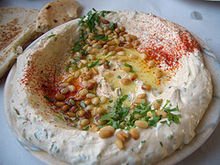Hollandaise sauce

Hollandaise sauce (/hɒlənˈdeɪz/ or /ˈhɒləndeɪz/; French: [ʔɔlɑ̃dɛz]), formerly also called Dutch sauce,[1] is an emulsion of egg yolk, melted butter, and lemon juice (or a white wine or vinegar reduction). It is usually seasoned with salt, and either white pepper or cayenne pepper.
Hollandaise is considered one of the five mother sauces in French cuisine. It is well known as a key ingredient of eggs Benedict, and is often served on vegetables such as steamed asparagus.[2][3][4]
Sauce hollandaise is French for “Dutch sauce”.[note 1] The name implies Dutch origins, but the actual connection is unclear.[1] The name “Dutch sauce” is documented in English as early as 1573, though without a recipe showing that it was the same thing.[1] The first documented recipe is from 1651 in La Varenne’s Le Cuisinier François[7] for “asparagus with fragrant sauce”:[8]
make a sauce with some good fresh butter, a little vinegar, salt, and nutmeg, and an egg yolk to bind the sauce; take care that it doesn’t curdle[8]
Not much later, in 1667, a similar Dutch recipe was published.[9] There is a popular theory that the name comes from a recipe that the French Huguenots brought back from their exile in Holland.[10]
La Varenne is credited with bringing sauces out of the Middle Ages with his publication and may well have invented hollandaise sauce.[11] A more recent name for it is sauce Isigny, named after Isigny-sur-Mer, which is famous for its butter.[6][12] Isigny sauce is found in recipe books starting in the 19th century.[13][14]
By the 19th century, sauces had been classified into four categories by Carême. One of his categories was allemande, which was a stock-based sauce using egg and lemon juice. Escoffier replaced allemande with egg based emulsions, including hollandaise and mayonnaise [15] in his list of the five mother sauces of haute cuisine.[16] While many believe that a true hollandaise sauce should only contain the basic ingredients of eggs, butter, and lemon, Prosper Montagne suggested using either a white wine or vinegar reduction, similar to a Béarnaise sauce, to help improve the taste.[17]
In English, the name “Dutch sauce” was common through the 19th century, but was largely displaced by hollandaise in the 20th.[1
